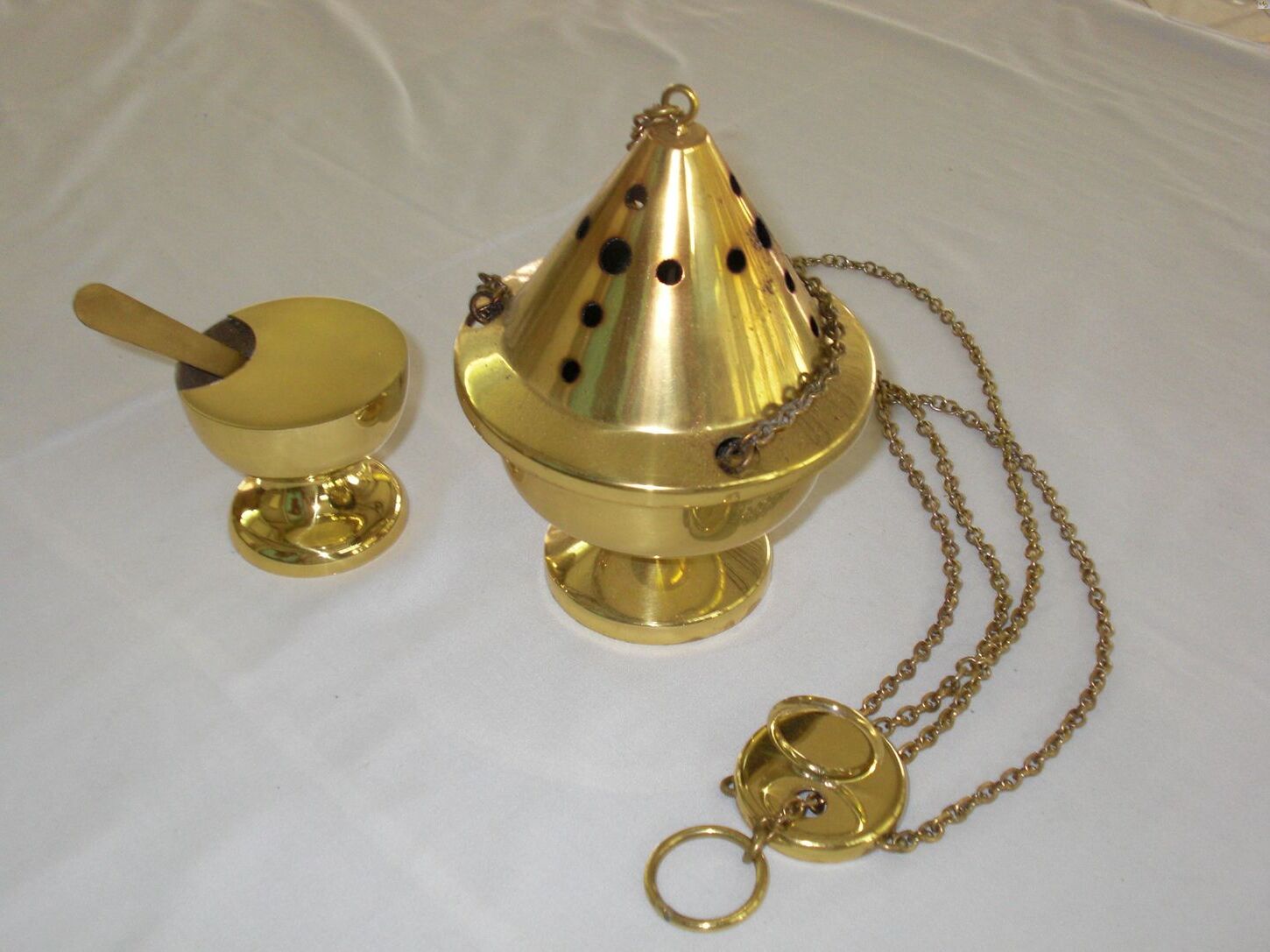
What is a thurible? A thurible, also known as a censer, is a special vessel used in Christian worship to burn incense. This practice dates back to ancient civilizations like the Egyptians, Greeks, and Romans. Early Christians adopted it, and it has evolved over centuries. Made from materials like silver, gold, or even wood, thuribles are often beautifully decorated. The incense burned in them, such as frankincense and myrrh, symbolizes prayers rising to God. The use of thuribles varies by liturgical season and is deeply rooted in tradition and symbolism. Whether in grand cathedrals or small chapels, thuribles play a significant role in creating a sacred atmosphere.
The Historical Origins of the Thurible
The thurible, also known as a censer, has a rich history that dates back to ancient civilizations. Its use in Christian worship has evolved over centuries, influenced by various cultures and traditions.
-
Historical Origins: The use of incense in worship dates back to ancient civilizations, including the Egyptians, Greeks, and Romans. Early Christians adopted this practice from their pagan predecessors.
-
Etymology: The word "thurible" comes from the Old French word "thurible," which is derived from the Latin "thuribulum," meaning "incense box".
-
Liturgical Use: In Christian worship, the thurible is used to burn incense, which symbolizes prayer rising to God. The act of burning incense is often accompanied by prayers and blessings.
Materials and Design
Thuribles are crafted from various materials and come in different shapes and designs, each with its unique features and significance.
-
Materials: Traditional thuribles are made from metal, often silver or gold, and sometimes decorated with intricate designs. Modern thuribles can also be made from other materials like wood or ceramic.
-
Shape and Design: The shape of a thurible can vary, but it typically consists of a metal frame with a perforated bottom to allow the incense to burn. Some thuribles have multiple levels or compartments.
The Incense and Its Symbolism
Incense plays a crucial role in the use of the thurible, with its aromatic properties and symbolic meanings.
-
Incense: The incense used in thuribles is usually made from aromatic plants like frankincense, myrrh, and sandalwood. These plants are chosen for their pleasant fragrance and symbolic significance.
-
Burning Process: The incense is typically placed in the thurible and lit with a match or lighter. The burning process is often accompanied by prayers and blessings from the clergy.
-
Symbolism: The burning of incense symbolizes the prayers of the faithful rising to God. It also represents the purification and sanctification of the worship space.
Cultural Influences and Liturgical Seasons
The use of the thurible varies across cultures and liturgical seasons, each adding its unique touch to the practice.
-
Cultural Influences: The use of incense in Christian worship has been influenced by various cultures, including the Byzantine and Eastern Orthodox traditions. Each culture has its unique way of preparing and using incense.
-
Liturgical Seasons: The use of the thurible varies depending on the liturgical season. For example, during Lent, the thurible is often used more frequently to symbolize repentance and purification.
Clerical Use and Aromatic Properties
The thurible is often used by clergy during worship services, and its aromatic properties are widely recognized.
-
Clerical Use: In many Christian traditions, the thurible is used by the clergy during worship services. The priest or deacon will typically swing the thurible in a circular motion to distribute the fragrance of the incense.
-
Aromatic Properties: The aromatic properties of incense have been recognized for their therapeutic benefits. Many people find the scent of incense to be calming and relaxing.
Artistic Significance and Historical Preservation
Thuribles are not only functional but also artistic pieces that hold historical significance.
-
Artistic Significance: The thurible is often decorated with intricate designs and ornaments, making it a piece of art in its own right. Many artists specialize in creating beautiful thuribles for liturgical use.
-
Historical Preservation: Many historical thuribles are preserved in museums and churches as artifacts of the past. These pieces provide valuable insights into the evolution of liturgical practices.
Modern Adaptations and Ecumenical Use
Modern adaptations and the ecumenical use of the thurible show its continued relevance in contemporary worship.
-
Modern Adaptations: Modern adaptations of the thurible include electric incense burners and scented candles. These alternatives are often used in non-liturgical settings to create a peaceful atmosphere.
-
Ecumenical Use: The use of the thurible is not exclusive to any particular Christian denomination. Many churches across different denominations use the thurible as part of their worship services.
Scriptural References and Liturgical Rites
The thurible's use is deeply rooted in scripture and various liturgical rites.
-
Scriptural References: The use of incense in worship is mentioned in the Bible, specifically in the book of Exodus where Moses is instructed to make an altar of incense for the tabernacle.
-
Liturgical Rites: The use of the thurible is an integral part of various liturgical rites, including the Mass, Vespers, and Compline. Each rite has its unique way of incorporating the thurible into the service.
Preparation and Forms of Incense
The preparation of incense and its various forms are essential aspects of using the thurible.
-
Preparation of Incense: The preparation of incense involves mixing aromatic plants with resin and other ingredients. The mixture is then formed into small cones or sticks that are burned in the thurible.
-
Incense Cones: Incense cones are a popular alternative to loose incense. They are easier to use and provide a consistent fragrance throughout the burning process.
-
Incense Sticks: Incense sticks are another common form of incense. They are made by dipping bamboo sticks into a mixture of incense and resin, which is then dried and ready for use.
Incense Burners and Accessories
Various accessories complement the use of the thurible, enhancing the overall experience.
-
Incense Burners: Incense burners are designed to hold the incense and allow it to burn safely. They come in various shapes and sizes, from simple ceramic burners to elaborate metal ones.
-
Incense Trays: Incense trays are used to catch the ashes and residue from the incense. They are often made from metal or ceramic and come in different designs to match the thurible.
-
Incense Censers: Incense censers are similar to thuribles but are often larger and more ornate. They are used in grand ceremonies and processions to create a dramatic effect.
-
Incense Pouches: Incense pouches are small bags filled with incense that can be hung in the worship space. They provide a continuous fragrance without the need for a thurible.
Incense Charcoal and Resin
The materials used to light and create incense are crucial for its proper use.
-
Incense Charcoal: Incense charcoal is used to light the incense. It is made from natural materials like coconut shells or bamboo and is designed to burn slowly and evenly.
-
Incense Resin: Incense resin is the base material used to make incense. It is derived from plants like frankincense and myrrh and is mixed with other ingredients to create the desired fragrance.
Incense Blends and Safety
Creating unique incense blends and ensuring safety are important aspects of using the thurible.
-
Incense Blends: Incense blends are mixtures of different aromatic plants and resins. They are designed to create unique fragrances that can be used in various settings, from worship services to meditation rooms.
-
Incense Safety: Burning incense can pose safety risks, including fire hazards and respiratory problems. It is essential to use incense in well-ventilated areas and follow proper safety guidelines.
Regulations and Traditions
The use of incense is subject to regulations and is deeply rooted in various traditions.
-
Incense Regulations: The use of incense is regulated in some countries due to health concerns. For example, some cities have banned the use of incense in public places due to air quality issues.
-
Incense Traditions: The use of incense is an integral part of many cultural and spiritual traditions. It is used in various ceremonies and rituals to purify and sanctify the space.
Symbolism and Preparation Techniques
The symbolism of incense and the techniques used to prepare it are essential to its use.
-
Incense Symbolism: The symbolism of incense varies across cultures and traditions. In some cultures, it represents purification, while in others it symbolizes prayer and devotion.
-
Incense Preparation: The preparation of incense involves a combination of traditional techniques and modern methods. Some artisans specialize in hand-making incense using natural ingredients.
Storage and Handling
Proper storage and handling of incense ensure its quality and safety.
-
Incense Storage: Proper storage of incense is crucial to maintain its quality and fragrance. Incense should be stored in a cool, dry place away from direct sunlight.
-
Incense Handling: Handling incense requires care to avoid accidents. It is essential to handle incense sticks and cones carefully to avoid burns and other injuries.
Alternatives and Health Considerations
There are alternatives to traditional incense, and its health effects are a topic of ongoing debate.
-
Incense Alternatives: There are alternatives to traditional incense, including scented candles and essential oils. These alternatives can provide similar fragrances without the need for burning incense.
-
Incense and Health: The health effects of incense are a topic of ongoing debate. Some studies suggest that burning incense can release harmful chemicals into the air, while others argue that it has therapeutic benefits.
Spirituality and Culture
The use of incense is deeply rooted in spirituality and culture, playing a significant role in various practices.
-
Incense and Spirituality: The use of incense is deeply rooted in spiritual practices. It is used to create a meditative atmosphere and to connect with the divine.
-
Incense and Culture: The use of incense is an integral part of many cultural practices. It is used in various ceremonies and rituals to honor ancestors and deities.
The Art of Creating Incense
Creating incense is a specialized craft that requires skill and patience.
- Incense and Art: The art of creating incense is a specialized craft that requires skill and patience. Many artisans create beautiful incense blends and scents that are highly prized for their unique fragrances.
The Timeless Significance of the Thurible
The thurible isn't just a vessel; it's a bridge between the earthly and the divine. Its use, steeped in history and tradition, brings a sense of sanctity and reverence to worship services. From its ancient origins to its modern adaptations, the thurible has evolved but never lost its core purpose. Whether crafted from silver, gold, or ceramic, each thurible tells a story of faith and devotion. The incense it burns, often made from frankincense, myrrh, or sandalwood, symbolizes prayers rising to the heavens. Despite cultural and denominational differences, the thurible remains a unifying element in Christian worship. Its aromatic properties not only enhance the spiritual atmosphere but also offer a calming and therapeutic experience. In essence, the thurible continues to play a vital role in connecting the faithful with the divine, making it an enduring symbol of spirituality.
Was this page helpful?
Our commitment to delivering trustworthy and engaging content is at the heart of what we do. Each fact on our site is contributed by real users like you, bringing a wealth of diverse insights and information. To ensure the highest standards of accuracy and reliability, our dedicated editors meticulously review each submission. This process guarantees that the facts we share are not only fascinating but also credible. Trust in our commitment to quality and authenticity as you explore and learn with us.


